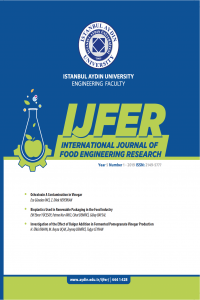INVESTIGATION OF LEAD, CADMIUM, ARSENIC AND MERCURY IN SOME SEAFOOD FROM BLACK SEA AND MARMARA SEA BY ICP-MASS SPECTROMETRY
INVESTIGATION OF LEAD, CADMIUM, ARSENIC AND MERCURY IN SOME SEAFOOD FROM BLACK SEA AND MARMARA SEA BY ICP-MASS SPECTROMETRY
Over the last 200 year our planet has been under a threat due to industrilization and environmental pollution. Accordingly, all the species living in our environmentally polluted planet is potentially a majör source of health risk. This situation is also directly leading to making the seafood and other species of waterborne is contaminated with the industrial pollutants such as heavy metals. The contaminated foods are suitable for the dissemination of these carcinogenic chemicals through the consumers. Heavy metals are the members of the third or higher rows of the periodic scale. In the present time, there are many heavy metals more than 60 such as lead, cadmium, chromium, cobalt, copper, nickel, mercury and zinc. The objective of this study was to analyze Pb, Cd, Hg, As in a total of 150 seafoods (10 shrimp, 10 calamari, 10 octopus, 10 mussel, 10 acorn, 10 mackerel, 10 coral, 10 sea bream, 10 whiting, 10 sole, 5 horse mackerel, 5 anchovy, 5 sardine, 5 bluefish, 5 gray mullet, 5 turbot, 5 red mullet, 5 coral, 5 bream, 5 butts fish) from Marmara Sea (n=75) and Black sea (n=75) by using Inductively Coupled Plasma-Mass Spectrometer ICP-MS according to the criterias by both Turkish Food Codex Declaration About Maximum Limits of Contaminants in Food Products (Declaration No: 2008/26) and NMKL 186 International method. The results revealed that the lead levels in both horse mackerel (0,385 ppm) and mullet (0,387 ppm) , and the mercury levels in both red mullet (1,707 ppm) and sea bream (1,098 ppm) from the Black sea were found to be higher, whereas the lead levels in both sardine (0,417 ppm) and butts fish (0,843 ppm) from Marmara Sea were higher than the upper limits as declared by Turkish Food Codex. In the mussels collected from Marmara Sea, the cadmium levels were found to be nearly close to the upper limit, which was 1 ppm. Also, it was provided that all the samples contained arsenic. However, no comment was performed since the Turkish Food Codex does not indicate any upper limit for itself. In Conclusion, this study provided that the seafoods collected from both Black sea and Marmara Sea significantly included heavy metals, including lead, mecury, cadmium, and arsenic. This situation leads to a significant foodborne health riskfor the public health and the Turkish consumers.
___
- [1] Kayhan FE. (2006): Su Ürünlerinde Kadmiyumun Biyobirikimi ve Toksisitesi. E.U. Journal of Fisheries & Aquatic Sciences, 23, 1-2, 215–220.
- [2] Çağlanırmak N., Hepçimen A.Z. (2010): Ağır Metal Toprak Kirliliğinin Gıda Zinciri ve İnsan Sağlığına Etkisi. Akademik Gıda, 8,2, 31-35.
- [3] Kaya Y., Duyar HA., Erdem ME. (2004): Balık Yağ Asitlerinin İnsan Sağlığı İçin Önemi. E.U. Journal of Fisheries & Aquatic Sciences, 21,3-4, 365-370.
- [4] Oehlenschlager, J. (2000): Identifying Heavy Metals in Fish. In: Safety and Quality Issues in Fish Processing (Ed. Bremmer, H.A.) pp. 95-108. Woodhead Publishing Limited. Cambridge, England.
- [5] Charya NS, Kamalaa CT, Rajb DSS. (2008): Assessing risk of heavy metals from consuming food grown on sewage irrigated soils and food chain transfer. Ecotoxicology and Environmental Safety, 69,3, 513–524.
- [6] ÖİKR. (2014): T. C. Kalkınma Bakanlığı Onuncu kalkınma Planı Su Ürünleri 2014-2018, ISBN 978-605- 4667-67-3, Ankara.
- [7] Bat L, Kaya Y, Öztekin HC. (2014): Heavy Metal Levels in the Black Sea Anchovy (Engraulis encrasicolus) as Biomonitor and Potential Risk of Human Health. Turkish Journal of Fisheries and Aquatic Sciences, 14: 845-851.
- [8] Cabré E, Mañosa M, Gassull MA.(2012): Omega-3 fatty acids and inflammatory bowel diseases - a systematic review. Br J Nutr, 107, Suppl 2, 240–252.
- [9] Levesque H.M., Moon T.W.., Campbell P.C.G., Hontela A. (2002): Seasonal variation in carbohydrate and lipid metabolism of Yellow perch (Perca flavescens) chronically exposed to metals in the field. Aquatic Toxicol, 60,257-267.
- [10] El-Moselhy Kh.M., Othman AI, Abd El-Azema H et al. (2014): Bioaccumulation of heavy metals in some tissues of fish in the Red Sea, Egypt. Egyptian Journal of Basic and Applied Sciences, 1,2, 97–105.
- [11] Savaş H. (2010): Kaynağından sofraya su ürünlerinden gıda güvenliği. YUNUS Araştırma Bülteni Yıl 10 Sayı 1 Mart 2010.
- [12] Love DC, Rodman S, Neff RA, et al. (2011): Veterinary Drug Residues in Seafood Inspected by the European Union, United States, Canada, and Japan from 2000 to 2009. Environ. Sci. Technol.,45,7232–7240.
- [13] Jaishankar M, Tseten T, Anbalagan N et al. (2014): Toxicity, mechanism and health effects of some heavy metals. Interdiscip Toxicol, 7, 2, 60–72.
- [14] Francesconi K.A., Kuehnelt D. (2004): Determination of arsenic species: a critical review of methods and applications, 2000-2003. Analyst., 129,5,373-395.
- [15] Guha Mazumder DN (2008): Chronic arsenic toxicity & human health. Indian J Med Res. 128, 4, 436-447.
- [16] Choi BS, Choi SJ, Kim DW et al. (2010): Effects of repeated seafood consumption on urinary excretion of arsenic species by volunteers. Arch Environ Contam Toxicol. 58,1,:222-229.
- [17] Wadhwa N, Mathew BB, Jatawa S et al. (2012): Lipid peroxidation: mechanism, models and significance. Int J Curr Sci.3, 29–38.
- [18] Chen CW, Chen CF, Dong CD. (2012): Distribution and Accumulation of Mercury in Sediments of Kaohsiung River Mouth, Taiwan. APCBEE Procedia. 1, 153–158.
- [19] Järup L. (2003): Hazards of heavy metal contamination. British Medical Bulletin, 68, 167–182.
- [20] Irfan M, Hayat S, Ahmad A et al. (2013): Soil cadmium enrichment: Allocation and plant physiological manifestations. Saudi J Biol Sci.20,1,1-10.
- [21] Hosseini SV, Sobhanardakani S, Miandare HK et al. (2015): Determination
- ISSN: 2149-5777
- Başlangıç: 2015
- Yayıncı: İstanbul Aydın Üniversitesi
